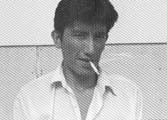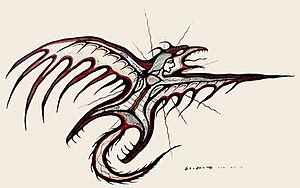Carl Ray facts for kids
Quick facts for kids
Carl Ray
|
|
|---|---|
 |
|
| Born | January 10, 1943 |
| Died | September 26, 1978 (aged 35) Sioux Lookout, Ontario
|
| Known for | Painter |
| Movement | Indian Group of Seven |
Carl Ray (born January 10, 1943 – died September 26, 1978) was a talented First Nations artist. He was active in the Canadian art world from 1969 until his passing in 1978. Carl Ray is known for his unique Woodlands Style paintings. He was also a founding member of the important Indian Group of Seven. He started painting seriously when he was 30 years old.
Contents
Carl Ray's Early Life and Art Journey
Carl Ray was born on January 10, 1943. His birthplace was the Sandy Lake First Nation reserve in northern Ontario, Canada. In his Oji-Cree community, people knew him as Tall Straight Poplar. This was because he was very tall, standing at 6 feet 4 inches. After his father passed away, Carl left residential school at age fifteen. He then tried to live a traditional life of hunting and trapping. However, he found this way of life difficult.
Even though he showed artistic talent early on, Carl was hesitant to paint. Elders in his community had told him not to paint the sacred beliefs and stories of his people. Because of this, he did not use a brush or paint for many years.
Carl later left the reserve to work in the gold mines near Red Lake. He faced some health challenges during this time. He eventually recovered in Fort William and returned home in 1966. Around this time, another famous artist, Norval Morrisseau, had started painting traditional stories. Morrisseau's success helped Carl feel confident to pursue his own art. Carl then began creating "legend paintings" as well as scenes of wildlife and northern landscapes.
Learning and Creating Art
Carl Ray learned from Norval Morrisseau, who was already a well-known artist. Carl helped Morrisseau work on a large mural for the Indians of Canada Pavilion at Expo '67 in Montreal. Morrisseau designed the mural, but Carl did most of the painting. Sadly, this amazing artwork was later lost. It was not cared for and was eventually taken down.
In 1971, Carl also created many illustrations for James Stevens' book, "Legends of the Sandy Lake Cree." These illustrations were very important. They helped show his unique artistic style to more people.
Carl also shared his art skills with others. With help from Robert Lavack, he toured schools in northern communities. He taught art in places like Kirkland Lake, Timmins, and Sudbury. In 1971, he also taught at the Manitou Arts Foundation. The next year, the Department of Indian Affairs sponsored his teaching tour through northern communities and reserves.
Growing Fame and Legacy
Carl Ray continued to develop his art throughout the mid-1970s. He painted large murals for schools and community centers. His smaller artworks also became very popular, especially with art collectors. In the early 1970s, Carl had his first solo art show. It featured his black and sepia Woodlands style paintings. This show was at the Aggregation Gallery in Toronto. This gallery continued to show his work for many years.
By 1975, the Indian Group of Seven had officially formed. Carl Ray was gaining recognition. Important collectors like Dr. Peter Lewin and Dr. Bernard Cinader bought his art. Public art collections, such as the McMichael Canadian Art Collection, also acquired his works. In 1976, he illustrated the cover of "The White City" by Tom Marshall. Carl Ray's art was often influenced by his personal experiences.
Carl Ray was known by his friends as a cheerful person. Fellow painter Alex Janvier described him as someone who loved to laugh and joke. Carl Ray passed away in Sioux Lookout in 1978. He was only 35 years old.
Carl Ray's Artistic Style
Carl Ray is most famous for his art in the Woodlands School of painting. This style is often called "legend painting."
His paintings might not have used very complex techniques, but they were full of powerful images. His unique, super-realistic pictures are easy to recognize. Carl once said about his art, "What you are looking at is ancient and sacred. In fact what you see could be described as a part of my soul." He put a lot of spiritual and emotional effort into his work. Many of his paintings used only two or three colors, like brown, black, and blue. He often mixed ink and watercolors.
Carl also created beautiful scenic paintings in a western style. These are less known but just as powerful. He often used bright electric blue colors in these works. They showed the wildlife and beauty of the Sandy Lake area. Sometimes, he even combined his two styles. He would paint his imaginative Cree legends with vibrant, electrifying colors.
Carl Ray's Art Exhibitions
Carl Ray's artwork was shown in many exhibitions during his lifetime and after.
Solo Exhibitions
- 1969: Brandon University, Manitoba.
- 1970: Confederation College, Thunder Bay, Ontario.
- 1971: Fort Frances Public Library.
- 1972: University of Minnesota, Minneapolis.
- 1972: Gallerie Fore, Winnipeg, Manitoba.
- 1972-1977: Aggregation Gallery, Toronto, Ontario.
Group Exhibitions
- 1974: Canadian Indian Art '74, Royal Ontario Museum, Toronto.
- 1974: Contemporary Native Arts of Ontario, Oakville Centennial Gallery, Ontario.
- 1975: Dominion Gallery, Montreal, Quebec.
- 1975: Wallack Gallery, Ottawa, Ontario.
- 1975: Art Emporium, Vancouver, B.C.
- 1976: Contemporary Native Arts of Canada - The Woodland Indians, Royal Ontario Museum, Toronto - travelling exhibition.
- 1977: Contemporary Indian Art - The Trail from the Past to the Future, Trent University, Peterborough, Ontario.
- 1978: Art of the Woodland Indian, McMichael Canadian Collection, Kleinburg, Ontario.
- 1979: Kinder des Nanabush, from the McMichael Canadian Collection, Kleinburg, Ontario.
- 1980: Contemporary Woodland Indian Painting, New College, University of Toronto, Ontario.
- 1983: Contemporary Indian Art at Rideau Hall, Department of Indian Affairs and Northern Development, Ottawa, Ontario.
- 1984: The Image Makers, Art Gallery of Ontario, Toronto - travelling exhibition.


